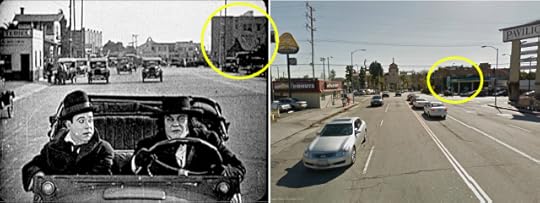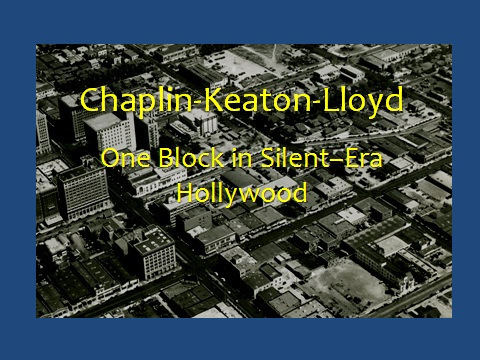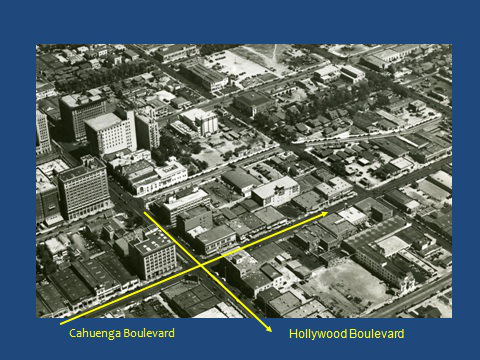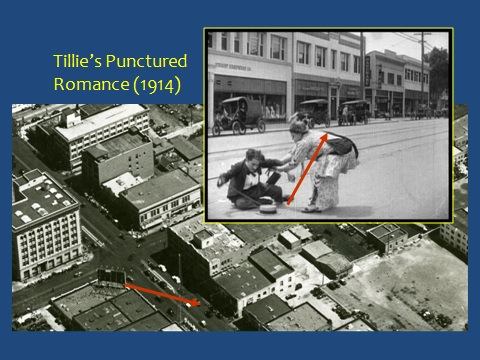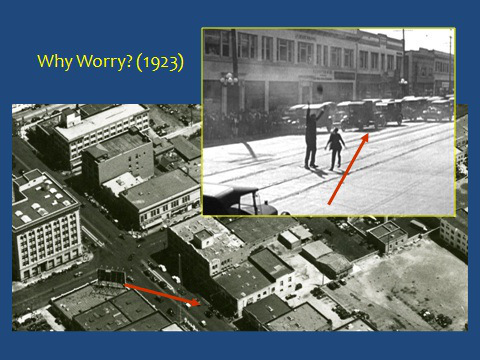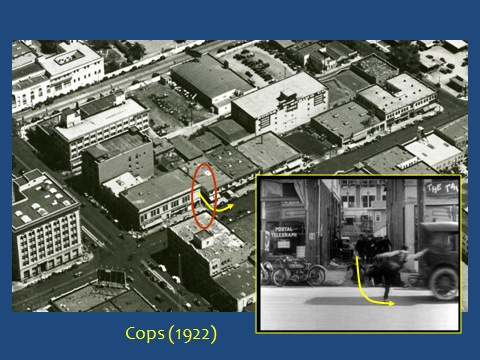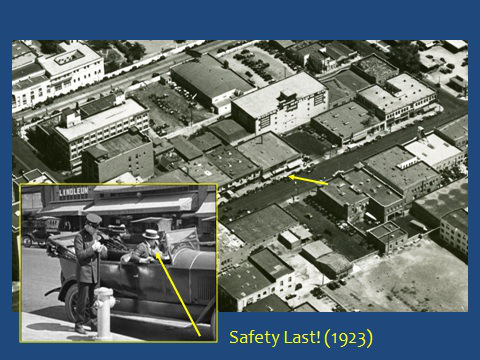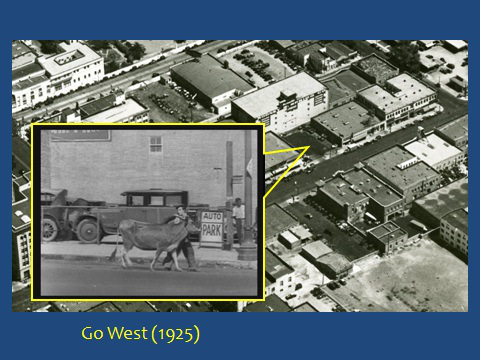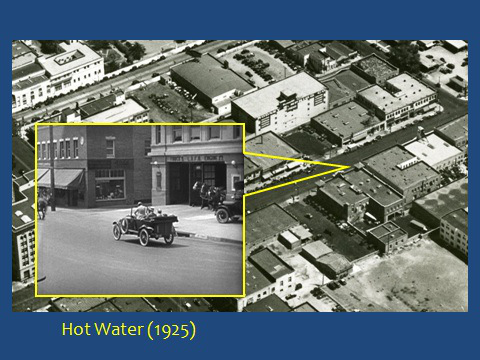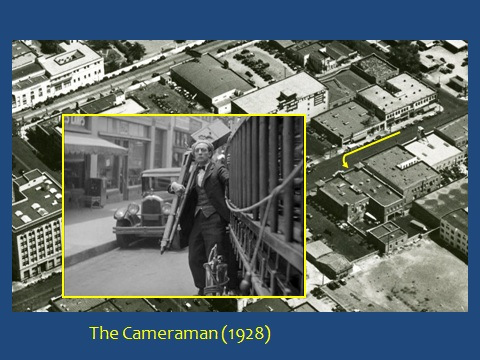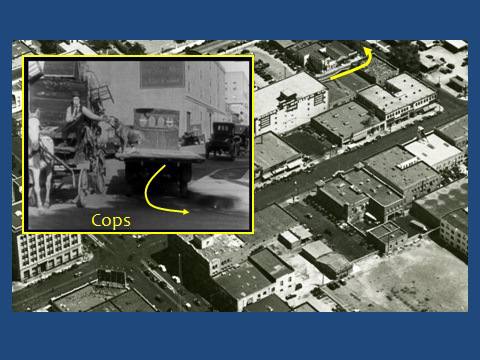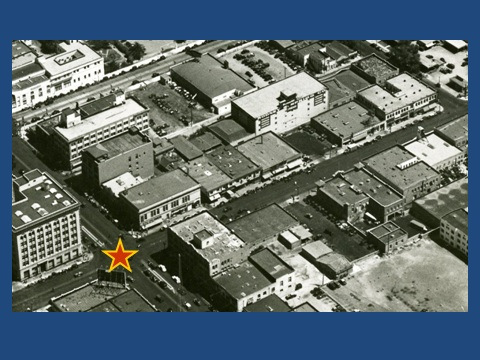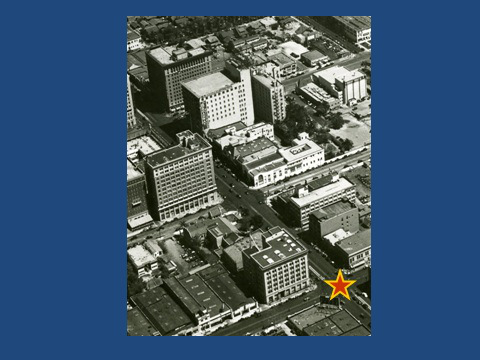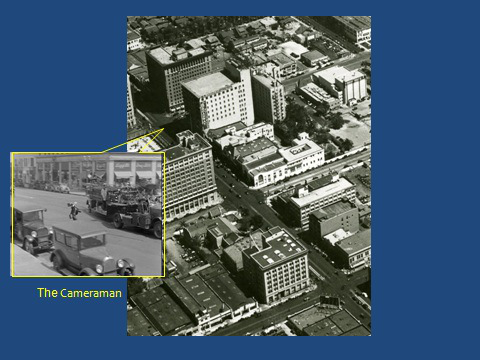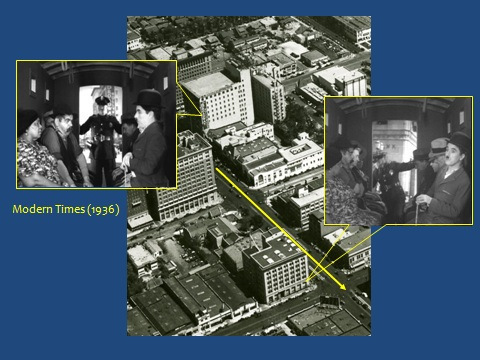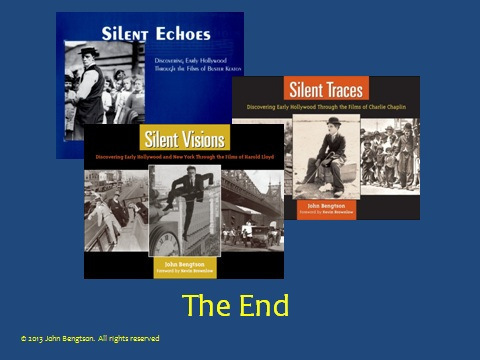John Bengtson's Blog, page 26
June 6, 2013
On the Fence – Keaton’s stunts in Cops and Our Hospitality
 In a recent post I showed how Buster Keaton staged his daring waterfall rescue from Our Hospitality (1923). In honor of the Los Angeles Chamber Orchestra’s presentation of Our Hospitality this June 8 at Royce Hall on the UCLA campus, here is another circa 1920s view of the “T” shaped pool on the former Brunton Studio backlot, now part of Paramount, where Buster filmed this amazing stunt.
In a recent post I showed how Buster Keaton staged his daring waterfall rescue from Our Hospitality (1923). In honor of the Los Angeles Chamber Orchestra’s presentation of Our Hospitality this June 8 at Royce Hall on the UCLA campus, here is another circa 1920s view of the “T” shaped pool on the former Brunton Studio backlot, now part of Paramount, where Buster filmed this amazing stunt.

Click to enlarge – San Diego Air and Space Museum
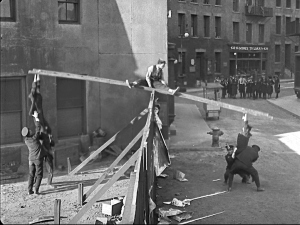
On the fence
The above view looks east – the red box marks the “T” shaped plunge near Melrose Avenue running along the far right. The yellow oval above marks a “Y”-shaped urban set that Buster used for a famous stunt on top of a fence (at left) in his 1922 short comedy Cops. Below, another view of the plunge (red box) and urban set (yellow oval), this time looking north from Melrose along the bottom towards the Hollywood Forever Cemetery at the top.

Click to enlarge hollywoodphotographs.com
Early in the movie Cops, Buster mistakenly believes he has purchased a horse and wagon from a street bum for $5.00. Behind them is a “MONEY TO LOAN” pawn shop set. This same set appears during Buster’s fence stunt.
Zooming in on the above northern looking aerial view, we get a direct view of where Buster filmed these scenes from Cops.

Click to enlarge. The directional arrow matches the arrow in the top-most aerial view.
Buster also filmed scenes from his later comedy short Day Dreams (1922) at the same urban street set on the former Brunton backlot (see below).
[image error]
Both from Day Dreams. The view to the left looks south along the Brunton Studio “Y”-shaped street set – the Cops fence location is out of view around the corner to the left. The “MONEY TO LOAN” sign appearing behind Big Joe Roberts at the right is marked with a yellow oval on the left.
The views above show how Buster used the “Y”-shaped street set for Day Dreams. Below, we can see portions of the Cops set as it appears in Day Dreams.

Click to enlarge. The same entrance cornice (red box) and policeman’s call box (yellow oval) appear in both Cops to the left and Day Dreams to the right.
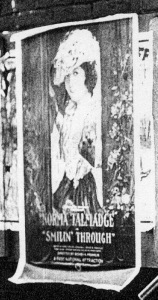 The matching views above show how the elements from the Cops fence set appear in Buster’s later film Day Dreams. Buster used the same “Y”-shaped set further in Day Dreams for the failed-thespian sequence where Buster is physically kicked out of a theater. As a discreet homage to his two sisters-in-law, the famous actresses Norma and Constance Talmadge, Buster placed movie posters from their films on the theater wall. This poster (left) from Norma’s 1922 feature Smilin’ Through can be seen in the right movie frame above, just to the left of the yellow oval.
The matching views above show how the elements from the Cops fence set appear in Buster’s later film Day Dreams. Buster used the same “Y”-shaped set further in Day Dreams for the failed-thespian sequence where Buster is physically kicked out of a theater. As a discreet homage to his two sisters-in-law, the famous actresses Norma and Constance Talmadge, Buster placed movie posters from their films on the theater wall. This poster (left) from Norma’s 1922 feature Smilin’ Through can be seen in the right movie frame above, just to the left of the yellow oval.
I explain on bonus features of the Kino-Lorber Keaton Short Films collection, and hope to write here in future posts, how Buster also filmed scenes from Cops on the backlots of the former Metro Studio, directly across the street from his own small studio in Hollywood, and at the Goldwyn Studio in Culver City.
Cops, Day Dreams, and Our Hospitality licensed by Douris UK, Ltd.
The blue square in the Google aerial view below is the current Paramount Studios pool/parking lot. The Brunton plunge stood to the lower right of the corner of Windsor Blvd. and Valentino Pl.
View Larger Map
Filed under: Buster Keaton, Cops Tagged: Buster Keaton, Cops, Hollywood, How Buster filmed Cops fence stunt, How Buster filmed Our Hospitality waterfall stunt, How Buster Keaton filmed fence stunt, How Buster Keaton filmed waterfall stunt, Keaton Locations, Keaton Studio, Los Angeles Chamber Orchestra, Silent Comedians, Silent Comedies, Silent Movie Locations, Silent Movies, then and now

May 31, 2013
Keaton location to be demolished – photo help?
I just discovered where Keaton filmed a scene from Cops (1922), as Big Joe Roberts retrieves his wallet from Buster (but not its cash contents) by leaning out to grab it from a passing taxi. The scene was filmed at the corner of Sunset and Detroit, a block diagonally from the Chaplin Studio.
One apartment appearing in the scene is (momentarily) still standing, but I found online that a demolition permit for the building was issued just last week, on May 24, 2013. The view looks east down Sunset from Detroit. The yellow oval marks the trees along Sunset in front of the mansion, north of the Chaplin Studio on La Brea, where Charlie’s brother Syd resided.

Click to enlarge. The red box and yellow oval match the above movie frame. The blue oval is a small real estate office, see below. The Chaplin Studio backlot shows a tent built for Chaplin’s 1928 feature The Circus
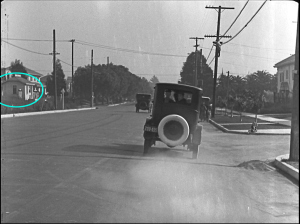
Buster rides off with Joe’s taxi and cash. Notice the little girl watching, sitting on the corner, and the telephone lineman above her. The corner real estate office (blue oval) appears in the aerial view above.
The apartment at 7130 W. Sunset Blvd. will not be standing much longer, but perhaps some Keaton fan in the Hollywood area could dash over and take some photos before it disappears.
This is the first time in 15 years that I have become aware of a location at the same time its demolition was imminent.
Thank you for any help -
John Bengtson
PS – no matter what, I love the fact that Buster filmed this scene around the corner from the Chaplin Studio! Some how knowing this makes me appreciate Cops, Charlie, and Buster all the more.
Cops licensed by Douris UK, Ltd.
View Larger Map
Filed under: Buster Keaton, Chaplin Studio, Cops, Hollywood Tour Tagged: Buster Keaton, Chaplin Studio, Cops, Hollywood, Hollywood Tour, Keaton Locations, Silent Comedians, Silent Comedies, Silent Movie Locations, Silent Movies, then and now

May 21, 2013
How Harold Lloyd Filmed Safety Last (the parts on the ground)

Click to enlarge – Hollywood Boulevard and Cahuenga – circa 1922
 The alleys at the SE corner of Hollywood Boulevard and Cahuenga are certainly the most historically significant silent film locations in town. The yellow arrow above marks the alley entrance from which Buster Keaton grabs a passing car one-handed in Cops (1922). But the back of the same alley portrayed the employee entrance of the De Vore Department Store (red box above), where Harold Lloyd’s character works in Safety Last! (1923). I explain how Harold filmed the hanging-from-the-clock stunt in Safety Last! at this post, and how Cosmos Street, the alley connected to the alley shown here, also appears in Safety Last! and Cops at this post. But we’ll focus now on how two of the most iconic silent film comedies were filmed at the same spot.
The alleys at the SE corner of Hollywood Boulevard and Cahuenga are certainly the most historically significant silent film locations in town. The yellow arrow above marks the alley entrance from which Buster Keaton grabs a passing car one-handed in Cops (1922). But the back of the same alley portrayed the employee entrance of the De Vore Department Store (red box above), where Harold Lloyd’s character works in Safety Last! (1923). I explain how Harold filmed the hanging-from-the-clock stunt in Safety Last! at this post, and how Cosmos Street, the alley connected to the alley shown here, also appears in Safety Last! and Cops at this post. But we’ll focus now on how two of the most iconic silent film comedies were filmed at the same spot.
To begin, in Safety Last! go-getter Harold always arrives early for work, but finds himself, after a moment’s distraction, locked in the back of a laundry wagon, with a deaf teamster at the wheel unable to hear Harold’s cries for help. As shown above, the wagon turns south from the “Cops” alley onto Cosmo Street. The Markham building to the left has been re-modeled over the years (in fact the upper floor has been removed), but the Palmer Building at back (once home to the Hollywood Daily Citizen newspaper) confirms the location.
Later in the film, Harold formulates a plan to sneak into work late, by posing as a store mannequin. The red boxes show matching elements of the Palmer Building.
You can see matching window elements on the Palmer Building in this view from Cops. As evident, the building was still under construction when Buster filmed here early in 1922, but was completed by the time Harold filmed late that same year. The building on the left side of the alley was rebuilt in the 1930s, causing the alley to become a bit more narrow.
In Safety Last! Harold convinces his room-mate Bill Strother to play rough-house with a policeman who was Harold’s friend back home. Bill knocks down the wrong cop, played by Noah Young, who ends up chasing Bill for the remainder of the film. This establishing shot above of Harold’s policeman friend was filmed looking north up Cosmo Street at the SW corner of the Palmer Building. It matches the yellow oval on the top aerial view.
This shot of Noah Young knocked to the ground looks west down the Cops alley (arrow), the same point of view Buster saw when he ran down the alley preparing for his amazing stunt. Note: time does not stand still. The alleyway marked with the arrow has recently been closed to vehicles to make room for outdoor dining, and the driveway on Cahuenga leading into the Cops alley is now blocked to traffic with a raised curb and pedestrian sidewalk.
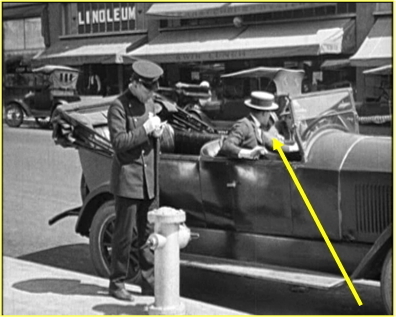 Safety Last! also contains a number of early scenes filmed on Cahuenga. At the left, a man giving Harold a lift back to work is ticketed for parking in front of a fire plug. The buildings behind Harold stand on Cahuenga a bit south of the Cops alley, while the arrow corresponds to the aerial view above. The fire plug stood in front of the former joint fire/police station once located at 1625-1929 Cahuenga, that appeared in Buster Keaton’s feature films Three Ages (1923) and The Cameraman (1928). You can read more about the former fire/police station at this post.
Safety Last! also contains a number of early scenes filmed on Cahuenga. At the left, a man giving Harold a lift back to work is ticketed for parking in front of a fire plug. The buildings behind Harold stand on Cahuenga a bit south of the Cops alley, while the arrow corresponds to the aerial view above. The fire plug stood in front of the former joint fire/police station once located at 1625-1929 Cahuenga, that appeared in Buster Keaton’s feature films Three Ages (1923) and The Cameraman (1928). You can read more about the former fire/police station at this post.
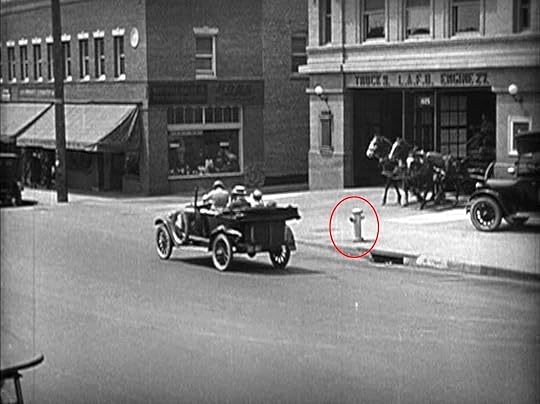 The movie frame at the right, from Harold Lloyd’s Hot Water (1924), shows the front of the fire station, and the same fire plug (red oval) that appears in the Safety Last! frame above.
The movie frame at the right, from Harold Lloyd’s Hot Water (1924), shows the front of the fire station, and the same fire plug (red oval) that appears in the Safety Last! frame above.
Aerial photographs from HollywoodPhotographs.com.
HAROLD LLOYD images and the names of Mr. Lloyd’s films are all trademarks and/or service marks of Harold Lloyd Entertainment Inc. Images and movie frame images reproduced courtesy of The Harold Lloyd Trust and Harold Lloyd Entertainment Inc. Cops licensed by Douris UK, Ltd.
A view west down the Cops alley from Cosmo Street.
View Larger Map
Filed under: Buster Keaton, Cops, Harold Lloyd, Hollywood Tour, Lloyd Thrill Pictures, Safety Last! Tagged: Buster Keaton, Cops, Harold Lloyd, Hollywood, Hollywood Tour, Keaton Locations, Lloyd Studio, Lloyd Thrill Pictures, Man on the Clock, Safety Last!, Silent Comedians, Silent Comedies, Silent Movie Locations, Silent Movies, Stunt Climbing, then and now

May 15, 2013
Douglas Fairbanks, Edge of Doom, and Film Noir
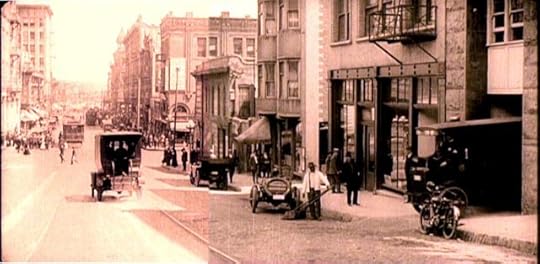
Click to enlarge. Looking east down 1st Street towards Broadway from the former City Jail (at right)
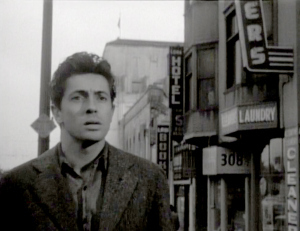
Farley Granger in Edge of Doom. The twin bay windows to his left appear in the center, above. The “modern” Los Angeles Times Building, that opened in 1935, stands tall in the far background.
During Douglas Fairbanks’ 1916 short comedy The Mystery of the Leaping Fish, a police van races from HQ down a quaint, post Victorian era Los Angeles street. Thirty-four years later, the same setting appears in the bleak film noir drama Edge of Doom, the same film, as I explain in this prior post, that shares a common setting on Witmer Street with both Harold Lloyd’s 1928 comedy feature Speedy, and the popular contemporary television sit-com The Office. As shown here, both the 1916 Fairbanks movie and the 1950 drama contain scenes filmed at the former Los Angeles City Jail (1897-1954) that once stood at 320-330 1st Street between Hill and Broadway.

Click to enlarge. The City Jail (cut off from bottom) stood on 1st Street between Hill Street to the left (note the early landmark twin-bore Hill Street Tunnel) and Broadway, at the center of the photo. The arrow points east down 1st Street starting from Broadway towards the Wilson Building (oval) at 1st and Spring. LAPL Photo 00044288

Click to enlarge. Both images show the distinctive dome tower of the Wilson Building that once stood at 1st and Spring. Tagging this unique dome was the key to solving this location mystery. The third Los Angeles Times Building (1912-1934) at 1st and Broadway appears to the far left of the movie frame. It was here that Charlie Chaplin filmed his first movie Making A Living in 1914. Photo LAPL 00018907

Click to enlarge. The jail vehicle entrance appears at the far left edge in this Edge of Doom movie frame, and is marked with an arrow showing the path of the police wagon in the 1916 Fairbanks movie frames above. Notice the triangular parapet that once stood atop the jail. Photo LAPL 00037446

Harold Lloyd in Never Weaken. The oval marks the jail parapet visible in the above right photo
Because the City Jail was located near Hill Street, it frequently appeared in the background of the various stunt and thrill comedies filmed above the Hill Street Tunnel overlooking 1st Street. This scene to the left from Harold Lloyd’s third stunt climbing comedy Never Weaken (1921) shows the jail in the background (oval). You can read more about how Lloyd filmed stunt comedies above the Hill Street Tunnel at this post HERE.

This view matches the Farley Granger movie frame above. The arrow matches the police wagon route, above. By this point the City Jail’s distinctive triangular parapet had been removed. USC Digital Archive CHS-33276
The Mystery of the Leaping Fish is an odd film, known for Fairbanks’ comic portrayal of a manic, drug-addled detective named Coke Ennyday. Whenever he needs a boost to defeat the villains, Doug injects himself with a fresh syringe, and like Popeye after eating his spinach, quickly dispatches the crooks. It is also a historically rich film, containing many scenes filmed near the Long Beach Pike, and beside Chinatown’s Ferguson Alley. I hope someday to discuss these other locations in a future post. But as shown here, Fairbanks now joins his brethren Chaplin, Keaton, and Lloyd, in filming at the classic downtown street corners that would later appear in film noir.
The Mystery of the Leaping Fish (1916)—Douglas Fairbanks: A Modern Musketeer Collection (David Shepard, Film Preservation Associates, Jeffrey Masino, Flicker Alley LLC). Edge of Doom Copyright 1950 The Samuel Goldwyn Company. HAROLD LLOYD images and the names of Mr. Lloyd’s films are all trademarks and/or service marks of Harold Lloyd Entertainment Inc. Images and movie frame images reproduced courtesy of The Harold Lloyd Trust and Harold Lloyd Entertainment Inc.
Below, only the 1935 Los Angeles Times Building remains in this 2011 view.
View Larger Map
Filed under: Film Noir, Harold Lloyd, Los Angeles Historic Core Tagged: Douglas Fairbanks, Edge of Doom, film noir, film noir locations, Harold Lloyd, Los Angeles Historic Core, Mystery of the Leaping Fish, Never Weaken, Silent Comedians, Silent Comedies, Silent Movie Locations, Silent Movies, then and now

May 7, 2013
Buster’s Paramount Backlot Plunge

Buster’s Our Hospitality waterfall stunt
Now that Buster’s complete silent film oeuvre is available from Kino on Blu-ray, and more historic Hollywood photos become available for study, we continue to learn more and more about how Buster crafted his amazing comedies. One fun discovery is learning how Buster filmed scenes from Cops (1922) on both the original Metro Studios backlot in Hollywood (across the street from his small studio) and at the Goldwyn Studios backlot in Culver City, two years before Metro would relocate to Culver City to join with Goldwyn to form M-G-M in 1924.
But Keaton employed another famous studio backlot to film two of the most iconic scenes of his career; the once long-lost high-dive gag from his 1921 short comedy Hard Luck, and the waterfall rescue stunt (above) that climaxes his second feature film Our Hospitality (1923). As we’ll see, both were filmed at the unique “T” shaped concrete pool (or plunge as they were called back then) that stood on the Robert Brunton Studio backlot just north of Melrose Avenue, now part of the current-day Paramount Studios lot.

Click to enlarge – the Brunton Studio plunge as it appears in Hard Luck, with the left base of the “T” shaped pool covered over. Many studios had backlot plunges, or pools, from which they could film water scenes, but only the Brunton Studio had a pool shaped like a “T” instead of a rectangle. Notice the distinctive background barn appearing in both images. The aerial view looks east down Melrose Avenue. The upper right corner shows part of the original Douglas Fairbanks Studio, at the SE corner of Bronson Avenue, now the site of Raleigh Studios.

Buster and his Chinese family in Hard Luck
During the climax of Hard Luck, Buster climbs a high diving platform, and hoping to impress the bathing beauties assembled to watch, performs a swan dive so far from the tower that he passes the far edge of the pool, and smashes through the brick deck creating a crater. The women peer deep into the hole, unable to see where he has gone. In what Buster would later recount as his biggest laugh-getting gag ever, years later Buster climbs back out of the crater, wearing Chinese garb, followed by his Chinese wife and their children. In many versions of this film, once considered lost, the movie fades out just as Buster attempts his dive. But in the special version of Hard Luck appearing in the Keaton Plus DVD from Kino, you can see the gag play out fully (see above). It appears that Buster’s dive to the pool deck was created using animated drawings, as his body travels horizontally in a fashion that defies physics. I originally thought Buster had performed the stunt for real, as it would have been possible to cover the left base of the “T” shaped pool with paper, painted to look like brick, that Buster could have dived through.

A side view of the Our Hospitality waterfall stunt set, built over the “T” shaped plunge at the Brunton Studios on Melrose. The miniature hillside set standing to the left appears behind Buster during scenes filmed at the brink of the falls (see below), creating the illusion that he was far up off of the ground.

The miniature hillside behind Buster is a set, apparent in the prior photo above.
During the climax of Our Hospitality, Buster rescues his girlfriend, played by his first wife Natalie Talmadge, from sweeping over the brink of a waterfall, by swinging like a pendulum from a rope tied to a log jammed in the rocks, grabbing her just as she starts to fall. Buster’s waterfall stunt set was built astride the special “T” shaped pool that stood at the Brunton Studio, readily apparent in these behind the scenes photos above and further below. The Brunton Studio plunge was located just north of Melrose, due east of where Windsor Boulevard terminates at what is now an entrance gate to the Paramount Studios. Buster’s small studio, at Eleanor and Lillian way, stood just a few blocks away.

Buster at the top of the waterfall set and practicing for the stunt – Paul Gierucki

The orientation of the “T” shaped water pool, just north of Melrose. Windsor Boulevard, not yet plotted on this 1921 map, terminates at Melrose just west of the plunge. The Robertson-Cole Studios and Brunton Studios depicted here are now all part of the modern Paramount Studios.

A front view of the Our Hospitality waterfall stunt set, looking west.

These shots from Our Hospitality of Buster scaling a cliff, left, and nearly falling from a cliff, center, were filmed on the waterfall stunt set, with the camera placed on its side, a technique frequently used during the 1960s Batman TV series, as Batman and Robin “climbed ” the face of an office building. The true image appears to the right.

The Paramount Studios Melrose Avenue gate across from Windsor Boulevard. The Brunton Studio plunge once stood on the lot to the right (east) of the modern gate.
Our Hospitality and Hard Luck licensed by Douris UK, Ltd. Special restored version of Hard Luck copyright 1987 The Rohauer Collection.
View Larger Map
Filed under: Buster Keaton Tagged: Buster Keaton, Hard Luck, Hollywood Tour, Keaton Locations, Our Hospitality, Our Hospitality waterfall stunt, Paramount Studios, Silent Comedians, Silent Comedies, Silent Movie Locations, Silent Movies, then and now, waterfall stunt

April 13, 2013
Author Appearance at TCM Classic Film Festival – Free Tour
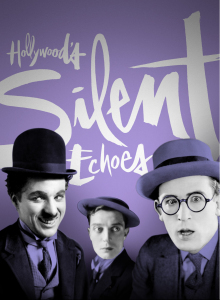 Attached to this post is a self-guided tour to Hollywood silent film locations and studios that I have prepared in connection with the “Hollywood’s Silent Echoes” presentation I will be giving April 28, 2013, at 3:00 p.m. at Club TCM in the Hollywood Roosevelt Hotel, as part of the Turner Classic Movie Channel Film Festival April 25-28. Although my talk is open only to festival passholders, with this tour you can follow a number of points I will cover during my presentation.
Attached to this post is a self-guided tour to Hollywood silent film locations and studios that I have prepared in connection with the “Hollywood’s Silent Echoes” presentation I will be giving April 28, 2013, at 3:00 p.m. at Club TCM in the Hollywood Roosevelt Hotel, as part of the Turner Classic Movie Channel Film Festival April 25-28. Although my talk is open only to festival passholders, with this tour you can follow a number of points I will cover during my presentation.
I will also discuss filming locations appearing in Buster Keaton’s 1926 masterpiece The General, which will be presented in a world premiere restoration. You can learn more about The General filming locations here. I will also have a special article appearing in the festival program, and will be doing a book-signing after my talk.
The tour starts at Hollywood and Vine, and encompasses over 40 filming locations and historic sites associated with Charlie Chaplin, Buster Keaton, and Harold Lloyd, including new discoveries not found in my books.
Club TCM Hollywood’s Silent Echoes Tour 2013
This year’s TCM Festival promises to be more exciting than ever – I hope to meet some of you there.
Filed under: Chaplin Tour, Hollywood Tour, Keaton Tour, Lloyd Tour, Uncategorized Tagged: Buster Keaton, Chaplin Locations, Chaplin Tour, Charlie Chaplin, Harold Lloyd, Hollywood, Hollywood Tour, Keaton Locations, Keaton Studio, Lloyd Studio, Silent Comedians, Silent Comedies, Silent Movie Locations, then and now

March 28, 2013
Cops and Safety Last! – the Cosmo Alley Connection
 We learn early in Safety Last! (1923) that Harold Lloyd’s roommate Bill Strother can climb tall buildings when we watch him escape from a policeman by scaling a four-story apartment building (left). The location of this building (perhaps now lost) continues to elude me, despite numerous telling clues, including the fact the building was situated on a trolley line, and stood adjacent to an alley across from a “California Garage” that sold tires. Does anyone know where this might be?
We learn early in Safety Last! (1923) that Harold Lloyd’s roommate Bill Strother can climb tall buildings when we watch him escape from a policeman by scaling a four-story apartment building (left). The location of this building (perhaps now lost) continues to elude me, despite numerous telling clues, including the fact the building was situated on a trolley line, and stood adjacent to an alley across from a “California Garage” that sold tires. Does anyone know where this might be?
Moments later in the movie, Bill meets up with Harold after scampering down a fire escape (below). The scene is edited as if Bill is returning to an alley behind the same building he had just climbed, but it does not match the alley appearing in the prior scenes. Thanks to the remarkable clarity from the pending Criterion Collection Blu-ray release of Safety Last!, we now know that this scene with Harold and Bill was filmed in Hollywood beside the Markham Building on Cosmo, the same alley where Buster Keaton filmed scenes appearing in his famous short film Cops (1922). You can read how Harold Lloyd filmed Safety Last! HERE.
During the scene, as Bill descends the ladder you can see busy traffic behind him along what turns out to be Hollywood Boulevard, and a sign across the street that reads “RICKERSH …” . In 1923, the RICKERSHAUSER & MILLER auto dealership stood at 6369 Hollywood Boulevard, directly across the street from where the alley Cosmo terminates. Comparing vintage views of the Markham Building with the movie frames confirms the setting.

Click to enlarge. Bill Strother scampers down the Markham Building fire escape.

Los Angeles Public Library
This 1922 aerial view above shows the Rickershauser dealership (oval) on Hollywood Boulevard across from the Markham Building, near the intersection of Cahuenga to the left. The rooftop arrow above shows the fire escape used by Bill to descend to the alley, and the arrow to the lower left above shows the point of view looking north up Cosmo for the scene from Cops described further below. At left is a closer view of the auto dealer across the street from Cosmo..

Click to enlarge. Front view of the Markham Building. The Huntington Library.

The Thief of Bagdad set
This 1924 view above shows the front of the Markham Building facing Hollywood Boulevard alongside Cosmo. The yellow arrow marks the point of view in Safety Last! looking north up Cosmo, the red arrow marks the fire escape ladder used by Bill Strother, and the yellow oval at back marks the towering set for the 1924 Douglas Fairbanks fantasy adventure The Thief of Bagdad, built on the Pickford-Fairbanks Studio at 7200 Santa Monica Boulevard. The Thief of Bagdad is also now available on Blu-ray.
During Cops below, as Buster Keaton signals a left hand turn from Cosmo onto Selma, his hand is bitten by a dog. The spot where Lloyd filmed beside the Markham Building can be seen in the far background (red box below).

Buster Keaton in Cops looking north up Cosmo towards the Markham Building.
The back of the Markham Building is also marked with a red box in the 1997 modern view above. You can see that at some point the fourth floor of the building was removed.
The neighborhood of Hollywood and Cahuenga depicted here was a very popular place for the silent comedians to film, which I describe in great detail in my books, and in many posts, including these concerning one block in Hollywood, describing Toberman Hall in Hollywood, and explaining nearby stunts performed by Harold Lloyd and Buster Keaton. You can read about how Harold filmed Safety Last! at this post.
Aerial photographs from HollywoodPhotographs.com.
HAROLD LLOYD images and the names of Mr. Lloyd’s films are all trademarks and/or service marks of Harold Lloyd Entertainment Inc. Images and movie frame images reproduced courtesy of The Harold Lloyd Trust and Harold Lloyd Entertainment Inc. Cops licensed by Douris UK, Ltd.
View Larger Map
Filed under: Buster Keaton, Cops, Harold Lloyd, Hollywood Tour, Safety Last! Tagged: Buster Keaton, Harold Lloyd, Hollywood, Hollywood Tour, Keaton Locations, Lloyd Locations, Lloyd Studio, Lloyd Thrill Pictures, Safety Last!, Silent Comedians, Silent Comedies, Silent Movie Locations, Silent Movies, Stunt Climbing, then and now

March 16, 2013
Keaton – Seven Chances Filmed Close to Studio
Now that the Keaton films are all available on Blu-ray, I not only continue to make new discoveries, but to my great satisfaction I am also increasingly able to place these filming locations into a broader context. As we will see, this scene below from Seven Chances (1925) was filmed just a few blocks away from Buster’s small studio.

Buster eyes a potential bride walking from Melrose down Rossmore.
The premise of Seven Chances (see related post HERE) requires Buster to become married by 7:00 pm in order to inherit a fortune. Before Buster outruns an army of angry brides at the film’s climax, he approaches a number of random women on the street. In this “joke” above, Buster recoils after realizing the potential bride he approached from behind is actually an African-American. Although this joke is overtly racial (one of the few in Keaton’s oeuvre), modern audiences may not realize that at the time it would have been illegal for Buster to marry this woman. It was not until 1948 that the California Supreme Court struck down California’s anti-miscegenation laws, the first time since the Reconstruction that a state had declared such laws to be unconstitutional.
Despite several clues, including the unusual curved street, and what appeared to be some type of church steeple (red oval) in the background, this setting eluded me for many years.

Click to enlarge. Harry Langdon and Vernon Dent travel north up Vine from Melrose in His Marriage Wow
But once I could read on the Blu-ray the 658 – 656 street numbers above the doorways during this scene, I realized it was likely filmed looking south from somewhere along Melrose Avenue, and eventually identified the setting as 658 N. Rossmore Avenue. Melrose is where the curved street Rossmore continues further north into Hollywood re-named as Vine Street.
This matching circa 1938 aerial view at left looks south, and shows Buster’s path beside the retail stores (arrow), the small church built in 1922 at 600 N. Rossmore, at the time called the Rossmore Avenue Congregational Church (red oval), and the extant Rossmore Apartments, built in 1924, at 649 N. Rossmore Avenue (yellow oval). The yellow box marks Arden Place, a newer “Y” branch street addition that was not present in 1925, that runs from Rossmore into Arden Boulevard, and the larger and more modern Christ the King Catholic Church built in 1927.
Also above to the left appear Harry Langdon and Vernon Dent, driving north up Vine from Melrose, in their 1925 Sennett Studio comedy His Marriage Wow. Their view looks south down Vine towards the same retail store (arrow), church (red oval), and apartments (yellow oval) on Rossmore, as in the left Keaton frame at the top of this post.

Click to enlarge. The red box marks the Keaton Studio at Lillian Way and Eleanor, the asterisks mark abandoned lots and sets of the former Metro Studio (by then Metro had left to merge into M-G-M in Culver City), the arrow at right marks Buster’s path down Rossmore from Melrose, and the yellow oval marks the extant Rossmore Apartments. Los Angeles Public Library

Click to enlarge. Another view looking north towards the Keaton Studio (red box), the Rossmore Apartments (yellow oval) and the original Rossmore Avenue Congregational Church (red oval). USC Digital Archive
Above, matching then and now views south down Vine towards Melrose and the extant Rossmore Apartments. Below, the Rossmore Avenue Congregational Church building as it appears today.
Seven Chances (C) 1925 Buster Keaton Productions, Inc. (C) renewed 1953 Loew’s Inc., licensed by Douris UK, Ltd.
View Larger Map
Filed under: Buster Keaton, Harry Langdon, Keaton Studio, Seven Chances Tagged: Buster Keaton, Harry Langdon, Hollywood, Hollywood Tour, Keaton Locations, Keaton Studio, Seven Chances, Silent Comedians, Silent Comedies, Silent Movie Locations, Silent Movies, then and now

March 3, 2013
Leave it to Skokie, and Beaver, and Ward’s Joke Letter
This post has nothing to do with silent movies, but I’ve really been enjoying watching Leave it to Beaver on Netflix instant streaming. When they showed this idyllic small town main street during a scene from “Beaver’s Fortune” (Season 3:Episode 10; first broadcast December 5, 1959), I had to hit the freeze frame to figure it out.

Leave it to Skokie

Skokie Public Library, Skokie History Project
Although Beaver takes place in “Mayfield,” set in an undetermined state that must have “Springfield” (the rootless home town featured in The Simpsons) for its neighbor, it turns out Skokie, Illinois appears during this stock footage shot (no actors from the show appear in this scene). The view looks north up Lincoln Avenue from Oakton Street towards St. Peter’s Catholic Church, originally built in 1894.
I was able to solve this easily enough, because even though Beaver was first broadcast over the airwaves in decidedly low-tech, low resolution, it was shot on 35mm “HD” film stock. I sensed a word on the bank sign said “Skokie,” and was proven right.
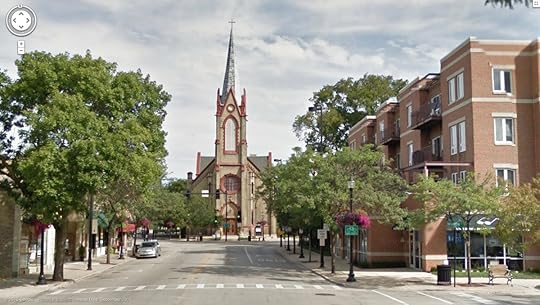
North up Lincoln at Warren Street, Skokie Illinois – (C) 2013 Google Inc.
It’s sad to see that the east side of Lincoln Avenue appearing during the scene has been replaced by a 1980s era bank plaza and related commercial buildings. The west side of Lincoln, appearing off camera, is relatively unchanged.
Watching a prior episode “Her Idol” (Season 2: Episode 6; first broadcast November 6, 1958), I nearly fell out of my chair when I noticed I was able to read this letter sent home from Beaver’s grade school principal. The person responsible for creating the prop letter obviously relied on the fact that the letter would appear only briefly on camera, in low resolution, without realizing that decades later technological advances would provide bored viewers such as myself the ability to scrutinize his handiwork. The full text of this letter appears below.
Mr. Ward Cleaver 485 Mapleton Drive Mayfield, State
My Dear Mr. Cleaver:
This paragraph has absolutely nothing to do with anything. It is here merely to fill up space. Still, it is words, rather than repeated letters, since the latter might not give the proper appearance, namely, that of an actual note.
For that matter, all of this is nonsense, and the only part of this that is to be read is the last paragraph, which part is the inspired creation of the producers of this very fine series.
Another paragraph of stuff. Now is the time for all good men to come to the aid of their party. The quick brown fox jumps over the lazy dog. My typing is lousy, but the typewriter isn’t so hot either. After all, why should I take the blame for these mechanical imperfections, with which all of us must contend. Lew Burdette just hit a home run and Milwaukee leads seven to one in the series. This is the last line of the filler material of the note. No, my mistake, that was only the next to last. This is last.
I hope you can find a suitable explanation for Theodore’s unusual conduct.
Yours truly, Cornelia Rayburn
 Well, after decoding this secret message, I felt pretty smug, but not being able to leave well enough alone, it crossed my mind to Google the text I had just deciphered, and low and behold, the Curious Case of the Beaver Letter had already been properly explored, long ago, at one of my favorite websites, Shorpy.com, “History in HD,” a site that posts fascinating high resolution vintage photographs. Here’s the link to the Shorpy treatment of Beaver’s letter. It makes me wonder what other Easter eggs from early television lie waiting to be discovered.
Well, after decoding this secret message, I felt pretty smug, but not being able to leave well enough alone, it crossed my mind to Google the text I had just deciphered, and low and behold, the Curious Case of the Beaver Letter had already been properly explored, long ago, at one of my favorite websites, Shorpy.com, “History in HD,” a site that posts fascinating high resolution vintage photographs. Here’s the link to the Shorpy treatment of Beaver’s letter. It makes me wonder what other Easter eggs from early television lie waiting to be discovered.
Leave it to Beaver – A GOMALCO Production.
View Larger Map
Filed under: Uncategorized Tagged: Leave it to Beaver, Shorpy, Skokie

February 18, 2013
Chaplin – Keaton – Lloyd – One Block in Silent-Era Hollywood (update)
The intersection of Hollywood Boulevard and Cahuenga Boulevard was a popular film setting for silent-era comedies. At the far end of this post is a link to download an animated 15 MB PowerPoint presentation showing thirteen (but not all) Chaplin, Keaton, and Lloyd filming locations near this historic intersection. If you prefer, here are some static images from the slide show. You can read more about the Toberman Building below appearing in Tillie’s Punctured Romance (1914) at this link HERE.
You will need a PowerPoint viewer to watch the show, and can download a PowerPoint viewer at this site.
Chaplin Keaton Lloyd – One Block in Silent Era Hollywood
All images from Chaplin films made from 1918 onwards, copyright © Roy Export Company Establishment. CHARLES CHAPLIN, CHAPLIN, and the LITTLE TRAMP, photographs from and the names of Mr. Chaplin’s films are trademarks and/or service marks of Bubbles Incorporated SA and/or Roy Export Company Establishment. Used with permission.
Keaton frame images reproduced courtesy of The Douris Corporation, David Shepard, Film Preservation Associates, and Kino International Corporation. The Cameraman (C) 1928 Turner Entertainment Co.
HAROLD LLOYD images and the names of Mr. Lloyd’s films are all trademarks and/or service marks of Harold Lloyd Entertainment Inc. Images and movie frame images reproduced courtesy of The Harold Lloyd Trust and Harold Lloyd Entertainment Inc.
HollywoodPhotographs.com – Bruce Torrence Historic Hollywood Collection (link).
View Larger Map
Filed under: Buster Keaton, Chaplin Tour, Charlie Chaplin, Cops, Girl Shy, Harold Lloyd, Hollywood Tour, Hot Water, Keaton Studio, Keaton Tour, Lloyd Studio, Modern Times, Safety Last!, The Cameraman Tagged: Buster Keaton, Charlie Chaplin, Harold Lloyd, Hollywood, Hollywood Tour, Silent Comedians, Silent Comedies, Silent Movie Locations, Silent Movies, then and now












